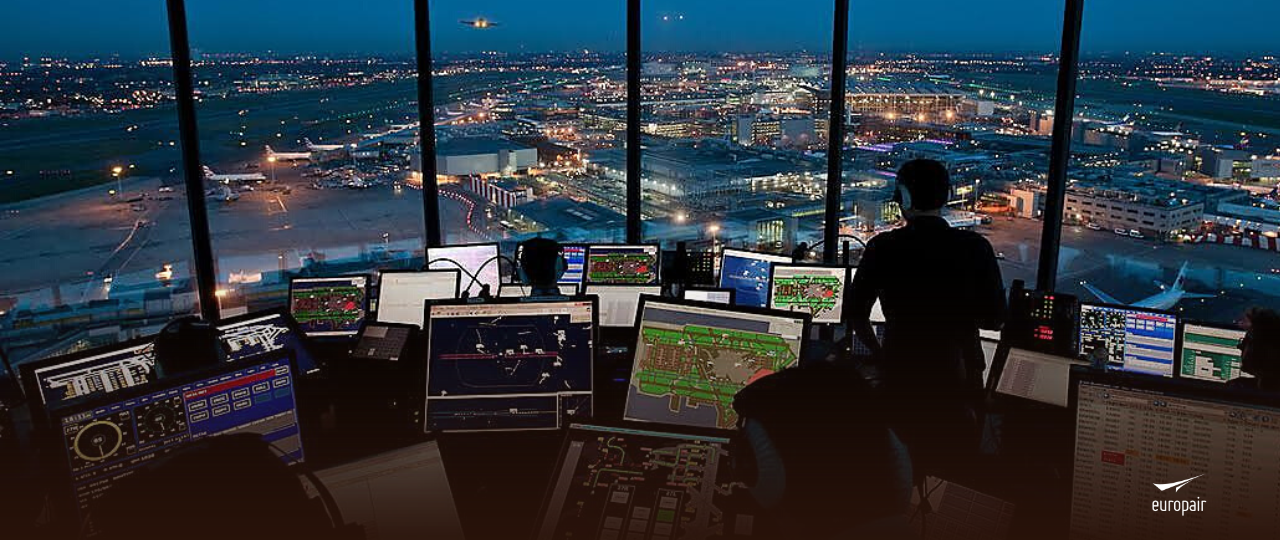
The skies, with us
Air traffic controllers; "the messengers of the sky"

Air traffic controllers; the messengers of the sky
The world of aviation is a fascinating and complex one, and there are many people working behind the scenes to make everything run efficiently and safely. One of the most important jobs is that of air traffic controllers, who are responsible for ensuring that planes take off, taxi and land in a safe and coordinated manner. In this blog, we will explore the work of air traffic controllers, their responsibilities, their training and the skills needed to succeed in this profession.
What are air traffic controllers and what are their responsibilities?
Air traffic controllers are professionals in charge of supervising and managing air traffic in a given area. Their job is to coordinate the take-off, flight and landing of aircraft to ensure safety and efficiency in the airspace. This includes coordinating with other air traffic controllers, communicating with pilots and ensuring that aircraft maintain a safe distance from each other.
Responsibilities of air traffic controllers:
Air traffic controllers have many important responsibilities. Some of these include:
- Supervising air traffic: Air traffic controllers are responsible for monitoring and managing air traffic in a given area, including ensuring that aircraft maintain a safe distance from each other.
- Controlling take-off and landing traffic: air traffic controllers are responsible for ensuring that aircraft take-off and land in a safe and coordinated manner.
- Coordinate with other air traffic controllers: air traffic controllers work as a team to ensure that air traffic is managed efficiently and safely.
- Communicate with pilots: air traffic controllers must communicate with aircraft pilots to provide them with important information such as weather conditions, altitude and wind direction.
- Tracking aircraft: air traffic controllers use advanced technology to track aircraft to ensure that they are flying safely and on the correct route.
Training and skills needed to be an air traffic controller:
Being an air traffic controller requires a great deal of specific training and skills. In general, air traffic controllers must have a combination of technical, communication and stress management skills.
What skills and training are necessary to be a successful air traffic controller?
- Academic training: Air traffic controllers must complete rigorous academic training in which they are taught the basic principles of aviation, navigation, regulations and air traffic procedures.
- Specialised training: After completing academic training, air traffic controllers must complete specialised training that provides them with practical skills in the use of air traffic control technology and in making critical decisions in high-pressure situations.
- Technical skill: Air traffic controllers must have advanced technical skills in using air traffic control technology, including radar and communications systems. They must also be able to use specialised software for air traffic monitoring and control.
- Communication skills: Air traffic controllers must have excellent communication skills to interact with pilots and other air traffic controllers. They must be able to communicate clearly and effectively in high-pressure situations and must be able to adapt their communication style for different situations and types of pilots. In this respect, air traffic controllers are considered "messengers of the sky" as they are the key players in the whole air-ground communication network.
- Stress management: Being an air traffic controller can be a very stressful job, requiring critical decisions to be made in high-pressure situations. Air traffic controllers must be able to manage their stress effectively to ensure that they can make accurate and effective decisions in any situation.
In addition to these skills and training, air traffic controllers must also meet specific physical requirements, such as having good vision and hearing, and having no health problems that could affect their ability to perform their job effectively.
Types of air traffic controllers:
There are several types of air traffic controllers, each with their own responsibilities and training requirements. Here are some examples:
- Tower controllers: tower controllers are responsible for overseeing air traffic at the airport, including coordinating the take-off and landing of aircraft.
- Approach controllers: Approach controllers work in areas close to the airport and are responsible for ensuring that aircraft are on the correct route and maintain a safe distance from each other.
- En-route traffic controllers: En-route traffic controllers work in air traffic control centres and are responsible for monitoring and managing air traffic in wider areas, such as the airspace between cities.
In short, air traffic controllers are crucial professionals in the world of aviation and their job is to ensure that air traffic is managed efficiently and safely.
Europair is at your service to bring you closer to the world of private aviation and charter flights: we will advise you throughout the contracting process, answer all your questions, and find the best solution according to your needs.
Do you need to hire a regional aircraft?
Contact us at web@europair.es or call +34913952025.



